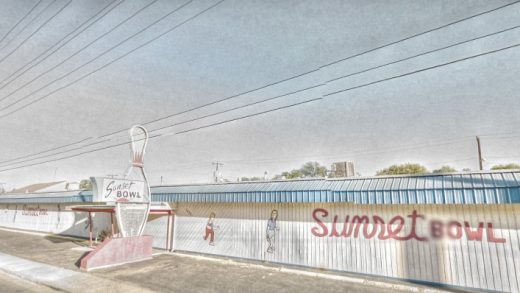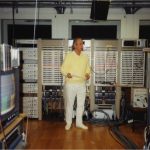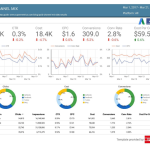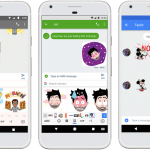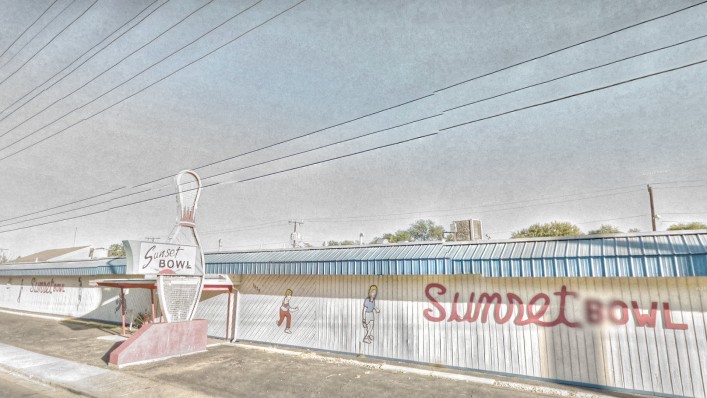How Google Street View Became An Art Form
On May 25, Google Street View celebrates its 10th birthday. A feature of Google Maps, it lets users explore cities and towns around the world—and even peer inside businesses and government institutions (including the White House). Games have sprouted out of Street View—like Geoguessr, in which players guess where in the world they’ve been randomly placed—while some users have documented funny images captured by the roving cameras of Google’s cars.
But Google Street View has also provided ample fodder for artists of all stripes, inspiring a range of creative works that include photographic curation, music videos, and impromptu performances.
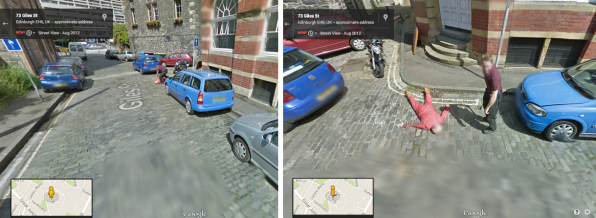
What, exactly, is it about Google Street View that makes it so appealing to creative types? Perhaps it allows us to experience the fantasy of what scholar Donna Haraway called “the God’s trick”—the impossible desire to see everything.
Never before have people had such easy, on-demand visual access to public spaces all over the globe, and over the past decade artists have wielded this immense power to comment on issues ranging from surveillance to sex work.
Curating From Google’s Vast Archive
The sheer magnitude of Google Street View’s all-seeing power is a subject for some artists. Michael Wolf’s project “A Series of Unfortunate Events” curates arresting images from Google Street View, ranging from bike accidents to fires. Taken as a whole, Wolf’s collection from Google’s vast archive gestures toward the vastness of the world itself. Taken individually, his images are both haunting and familiar.
Sometimes Google Street View appeals to artists for more political reasons. There can be a real discomfort with the technology, given that it amounts to one of the most comprehensive surveillance mechanisms in human history.
Jon Rafman’s ongoing project “The Nine Eyes of Google Street View” reflects the unsettling relationship between humans and surveillance. (The “nine eyes” in the title refers to the number of cameras on the pole attached to the top of a Google Street View car, although the number has since increased to 15.)
In 2008, one year after the launch of Street View, Google incorporated face-blurring technology to protect the identities of passersby captured by its cameras. But the technology isn’t without glitches. Rafman’s image of a man in a bunny costume with a blurred face next to a “real” person’s face draws an unsettling juxtaposition; it’s a reminder that Google Street View is incapable of telling the difference between this masked person and you. In so doing, Rafman’s image exploits the most basic fear of mass surveillance regimes: that you’ll be just another faceless entity.
Here are some pretty good pictures I took visiting some international beaches on Google Maps pic.twitter.com/OCPH9lM4fQ
— Keelayjams (@keelayjams) February 10, 2016
Other artists have taken a different approach. Doug Rickard, in an exhibition called “A New American Picture,” documented the “forgotten streets” of America by curating images of the disenfranchised in their downtrodden neighborhoods. Halley Docherty has used Google Street View to superimpose famous paintings and album covers on their modern settings (for example, the Beatles crossing the street on today’s Abbey Road). And Justin Blinder’s “Vacated” project turns Google Street View images into GIFs that alternate between before-and-after photos of gentrified street corners in New York City.
— Jon Rafman (@jonrafman) May 5, 2017
Posing For The Camera
Then there are the people who try to act out scenes in front of the passing cameras. While they may not identify as artists, they respond with an artist’s impromptu, creative ingenuity. Everyday folks see the Google car approaching and think up a scene—a staged birth in Berlin or a staged death in Scotland—and quickly react. In our research, we call these performance-events tableaux vivants (“living pictures”) in a nod to the evanescent vitality of scenes that come to life only to dissolve as quickly as they’ve been formed.
Street View art has its detractors. Mishka Henner, for his show “No Man’s Land,” cruised Street View for known “John” sites in Italy and Spain and culled images of women who may be sex workers. Although the show was shortlisted for the Deutsche Börse Photography Prize, it was also subject to mixed reviews. Some thought it was sexist to assume that the women depicted were, in fact, prostitutes, though they praised the way the images communicated the everyday vulnerability (and boredom) involved with sex work.
Perhaps most of all, the show inspired questions about the authorship of photographers who merely curate images taken by Google’s cameras. Nonetheless, as one critic pointed out, Google Street View has forced us to reconsider what street photography as a genre now means in light of Google’s roving cameras.
Related: A Selfie For The Planet
What’s next for this strange intersection of a mapping tool and art? We hesitate to make firm predictions, but we wouldn’t be surprised to see more collaborations between Google and artists, like Arcade Fire’s experimental music video that populates Google Street View images of the viewer’s childhood neighborhood in a nostalgic montage. We would also like to see more involvement by women, as most of the artists who work with Google Street View have tended to represent a male perspective.
After a decade, Google Street View is no longer new. But that doesn’t mean its potential for artistic action and intervention will subside. As the platform collects more and more images of the Earth’s public spaces—and as mixed, augmented, and virtual reality technologies become more pervasive—we expect that people will find new and inventive ways to make art out of a platform that has, from the start, been a surprising muse.
Allison L. Rowland is assistant professor of performance and communication arts, St. Lawrence University, and Chris Ingraham is assistant professor of communication, North Carolina State University.
This essay originally appeared on The Conversation. Share your own ideas, essays, tips, and suggestions with Fast Company by reaching us at ideas@fastcompany.com.
A zoom-in on the strange and sublime art of Street View, which turns ten years old this week.
On May 25, Google Street View celebrates its 10th birthday. A feature of Google Maps, it lets users explore cities and towns around the world—and even peer inside businesses and government institutions (including the White House). Games have sprouted out of Street View—like Geoguessr, in which players guess where in the world they’ve been randomly placed—while some users have documented funny images captured by the roving cameras of Google’s cars.
Fast Company , Read Full Story
(122)

